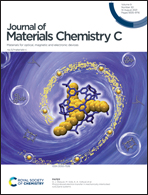Charge transfer doping with an organic layer to achieve a high-performance p-type WSe2 transistor†
Abstract
Two-dimensional WSe2, a transition metal dichalcogenide (TMD), is a promising intrinsic semiconductor due to its outstanding electrical and mechanical properties, useful for next-generation electronics. However, its pn coupling and logic applications require reliable n- or p-type doping methods. This study introduces a novel p-type doping method for WSe2 that is based on the use of an organic molecule, dinaphtho[2,3-b:2′,3′-f]thieno[3,2-b]thiophene (DNTT). Depositing DNTT on a WSe2 flake changed the WSe2 field-effect transistor (FET) from ambipolar with poor transistor characteristics to a high-performance p-type transistor. X-Ray photoelectron spectroscopy, Raman spectroscopy, and photoluminescence analyses show that the WSe2 flakes were successfully doped with hole charges from the top DNTT layer; moreover, scanning Kelvin probe microscopy observations revealed that the hole charges in the DNTT layer were transferred to the WSe2 flake. In addition, temperature–variable current–voltage analyses of the WSe2 FETs reveal that the required activation energy for charge transport (hopping) is significantly reduced and the subgap trap states are filled with additional doped charges. Thus, the proposed doping method based on charge transfer from an organic layer offers practical benefits for the manufacturing of high-performance TMD-based transistors.



 Please wait while we load your content...
Please wait while we load your content...